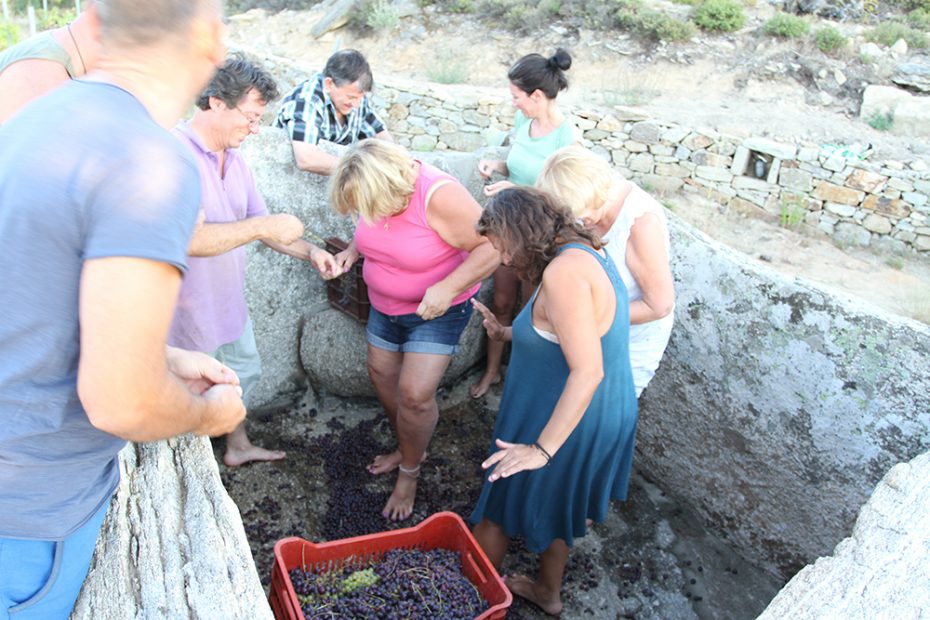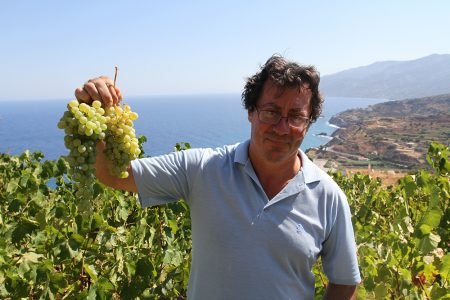The end of the summer on Ikaria is always filled with a sweet sadness. The light shifts ever so subtly from crisp white to hints of gold. Fall is imminent. We pack up the house. We say “Kalo Fthinoporo — Have a good autumn,” to friends who we won’t see for months, maybe for a full year. The garden brims with the plumpest vegetables now, and I spend the last days of summer trying to capture some of it in jars: pickles, sauces, jams are all up in my kitchen. The figs split open on trees, soft and ready. And, of course, the grapes are at their peak.
The end of summer is the most important time for wine making on Ikaria and elsewhere in temperate Greece. This year I did something I’ve always wanted to do: help make wine the old-fashioned way, by stepping on grapes in an old stone vat with my feet! Nikos Afianes, a local wine maker, invited us to join him in the production of one of his wines, a totally hand-crafted (or, foot-crafted!) vintage that is one of his premium wines.
My hubby and partner Vassilis Stenos shot a photo essay of the experience. Here’s a kind of step-by-step look at how the Ikaria’s famed Pramnian wine is traditionally made.
Know Thy Grapes!
Our first stop was one of the vineyards Nikos Afianes works with, just outside Avlaki, on the north side of the island, overlooking the coast. Here, grower Stelios Paidas produces Ikaria’s traditional grape varieties, Fokiano, the red grape pictured below, as well as Begleri, a local white grape, muscat grapes, and sultaninas. He uses these last two and the red Fokiano to produce raisins, too, which were once a renowned export from the island.
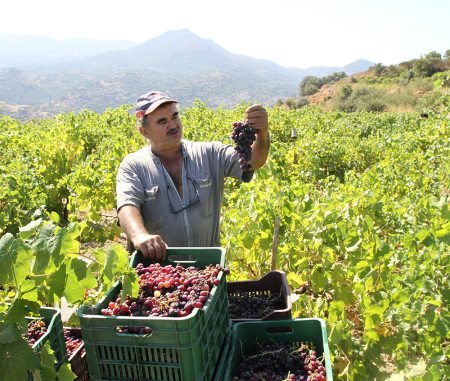
Fokiano grapes from a vineyard on the north side of Ikaria.
Every vintner and grape farmer I’ve ever met has told me that the vine is a hard task master, but it’s also a generous provider of much more than grapes. Nothing goes to waste and every part of the plant has its uses. At Paidas’ vineyard we got a glimpse of that, by witnessing part of two other production processes, the making of raisins and the selection of lesser grapes for making tsipouro.
Raisins and Tsipouro
Ikaria was once renowned for the production of raisins, which were, indeed, a major source of income for the island for centuries. Legend has it that Ikaria’s famed raisins were the favorite of the Turkish sultan. Several varieties are suitable for drying into raisins: the white muscat and sultanina grapes, both sweet and aromatic, and the red and sweet fokiano. Farmer Stelios makes raisins the traditional way.
He has dipped each and every cluster into a wood-ash solution called alisoiva, which is made by boiling wood ash, collected from the fireplace, with water for several hours and letting the solids settle to the bottom of the pot. The clear yellowish water is then drained off carefully. The wood-ash solution, pictured below, helps the raisin grapes retain their texture as they dry. The grapes are placed on nets on a particular slope in this vienyard, one which is swept by a constant sea breeze, which helps the grapes dry out without rotting. Air circulates under the nets, too.
He also makes use of the lesser grapes not suited for either wine or raisins, and collects them to use for making tsipouro, a uniquely Greek grape distillate not unlike Italian grappa.
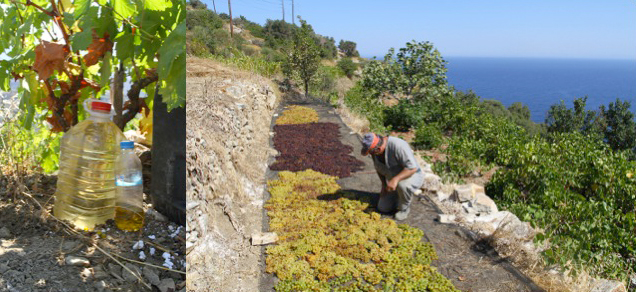
Wood ash solution and raisin grapes laid out to dry on a breezy slope.
Back to Wine Making…
Knowing the grapes doesn’t mean just understanding which varieties are suitable for wine making, raisins, and distillates. It also means understanding the nuances within the same variety and how those nuances affect the final product. Nikos Afianes, owner and spirit behind the Afianes vineyard in Profitis Ilias, Raches, displays the minutiae of grape clones. He explains the difference between two clones of the same variety, begleri, the local white grape, showing us an ever-so-slight difference in color. If you take a close look, you can see that the cluster of grapes on the left is slightly greener. This is an older manifestation of the same begleri variety and, ironically, produces wine that ages slightly bronze, a honey-colored white wine that is unique to Ikaria.
Let the Fun Begin: Making Wine the Old Way, by Foot!
After our visit to one of Nikos’ vineyards and a pretty lengthy explanation of grape clones, raisin production, tsipouro mash and more, we of course wanted to witness the real fun: pressing grapes the old way, by foot, at his winery. Nikos son, Constantine, pictured below, arrived around 4 the next day. He studied wine making in Bordeaux and has returned to Ikaria to work at the family vineyard.
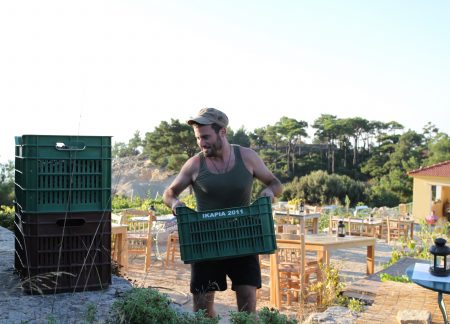
Grapes arrive for pressing!
Several loonies, myself included, were intent on participating in the fun of squashing grapes with our toes. Step one, of course, is to wash our feet, with a bar of soap laid out below the stone vat/press and a hose.
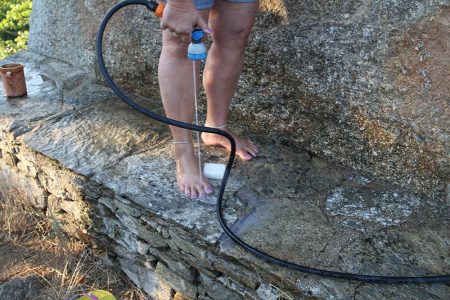
Washing our feet before going anywhere near those grapes!
Next, all of us are inside that huge tub/press, called a patitiri. Every traditional home on Ikaria has a patiriri since wine making on the island is a long-standing family tradition and the consumption of wine is one of the secrets to these islanders’ longevity.
Constantine feeds us the grape clusters bunch by bunch, we we take by hand and manually pull apart, separating the berries from the stems. This is perpahs the hardest part of the whole process. It’s laborious and tedious and a little tiring, since there are hundreds of kilos of grapes to comb off before we can really start to press.
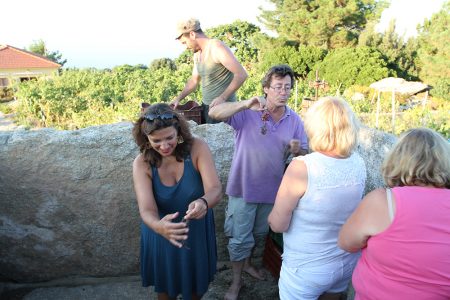
Getting the grapes ready for pressing by foot
As I mentioned, a few of us loonies wanted to squash grapes with our feet and we are just starting to here. There is an art to it, as Niko explained, and the best grape stompers were (unlike us in the picture below), quite skinny!
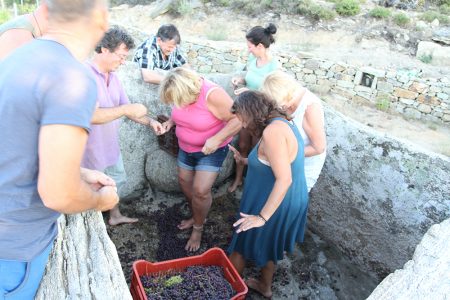
The pressing by foot starts slowly!
They did a kind of twist movement with their feet, a little dance, Niko explained, squeezing out as much of the juice as possible with their toes.
This is harder than it seems and it feels incredibly odd to squash warm, wet grapes by foot. At first, it’s startling to feel every part of those little berries, pits and all, breaking apart under the weight of my feet. It is slippery in the vat, too, especially as more and more grapes are tossed in.
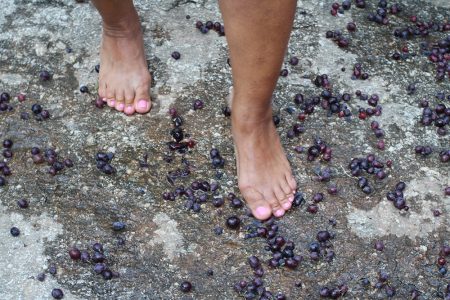
Twinkle toes!
Once the full load of all those kilos is cleaned through and stomped on inside the vat, a process that took us several hours around sunset and into the dark, Niko leaves the grapes uncovered overnight and well into the next day to macerate, which is what you are seeing below. The sugars develop that way, helping the final fermentation process.
We stomp on this mash some more and push it into the top corners of the vat, which is always built with a slight incline. This way, with the solids pushed u against the top, the juices can run down more freely.
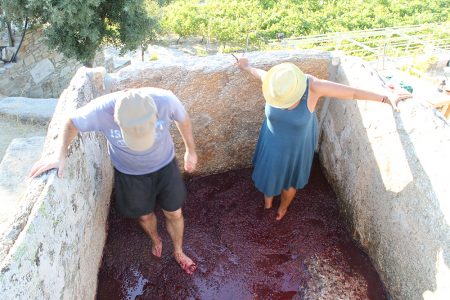
The grape juice, called must, is almost ready.
The must has fermented overnight and and a reading of it comes in at 14.7 percent alcohol! This is no simple grape juice, dear folks, but a very drinkable, highly potent pre-wine, that tastes great and puts a smile on our faces. Maria, Nikos wife and Constantine’s mom, enjoys the moment, too!
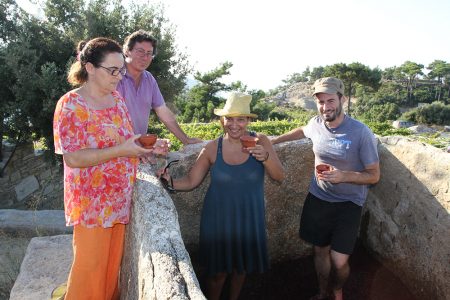
Tasting the fruits of our feet!
The must is sweet and slightly thick, chewy almost. It is delicious. We scoop it up with these small clay cups. and, as you can see by the rather loose-muscled smile on my face, we’ve tasted a fair amount of it. This slightly fermented must is collected for a few other uses, too. It is what petimezi, grape molasses, is made from, and it is used to make a delicious seasonal pudding called moustalevria. On Ikaria, parents give a sip of the must to their young ones, too, the better to help them sleep well through the night.
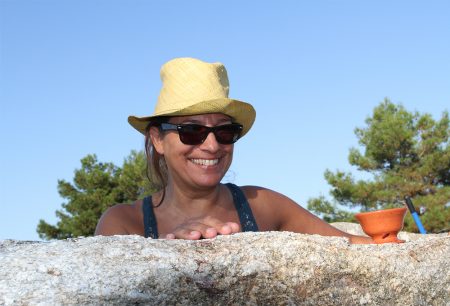
Yum and hiccup! The grape must is slightly fermented and makes us a little tipsy.
But the work goes on.
Constantine is in the vat above, out of sight in this picture, pushing the juices toward the spigot. Nikos collects the must in clay pots, to keep it all as pure and traditional as possible.
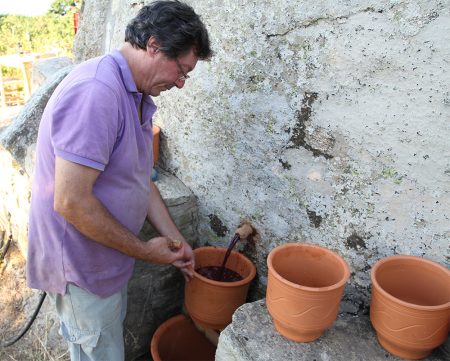
Collecting the must.
You can get a sense of the texture, that “chewy” quality I mentioned above, by seeing here how thick the grape must is. It doesn’t matter if pits and skins get in there. This helps the fermentation process, and anyway the solids settle at the bottom of the amphorae where this juice is left to ferment.
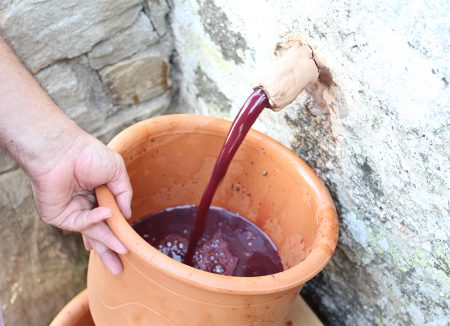
Nikos gathers the must in clay pots.
The island tradition was to ferment wine in huge amphorae buried in the ground. You can see them lined up below. The temperature inside the amphorae is naturally cool, and old-timers knew that under these conditions the must takes around 40 days to ferment. The ambient temperature inside these large clay vessels is around 16 – 17 degrees Celsius, much cooler than it is inside the large stainless-steel fermentation tanks that most wine makers employ, albeit they control the temperature with technology.
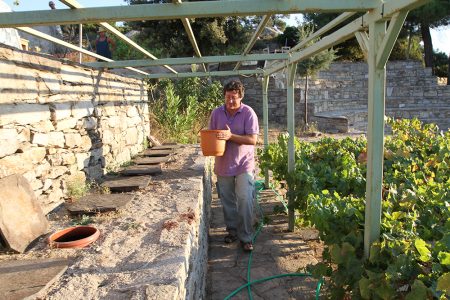
Nikos carries the must to a larger clay amphorae.
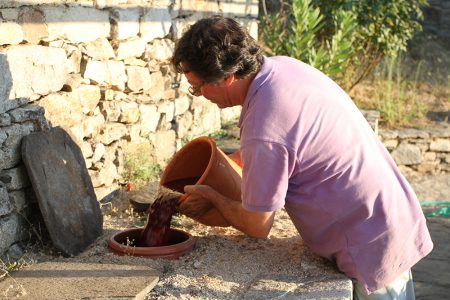
Pouring out the must into clay amphorae.
As part of the traditional process for making wine, Nikos also collects some of the grape mash, the skins, really, which help the wine develop a rich, deep red color.
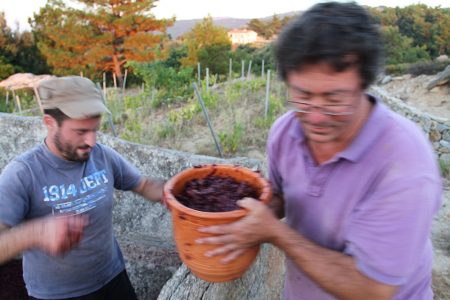
Some of the mash goes inside the amphorae, too.
And, finally, abiding by yet another traditional piece of wisdom, Nikos stops up the stone slabs that cover each buried amphora with akisaria, aka laudanum, a plant that grows wild all over Ikaria, has a variety of pharmaceutical uses and is known locally, among other things, for its antiseptic qualities. The wisdom of ages passed down ad put to use my modern wine makers!
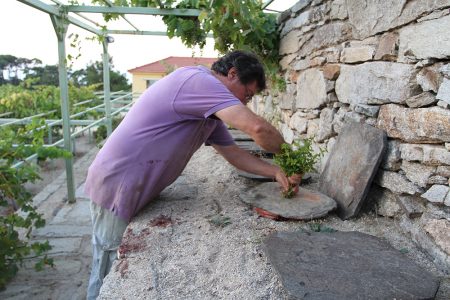
Covering up the amphorae.
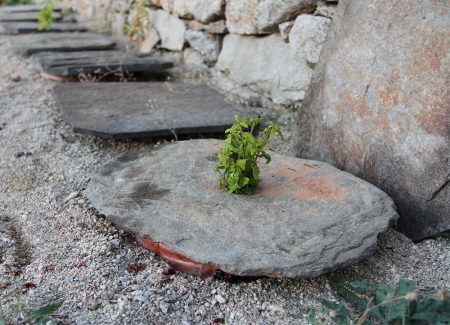
In 40 days this will be wine.

